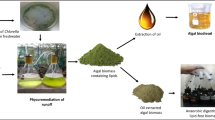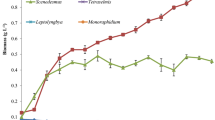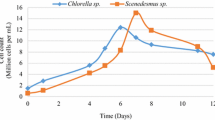Abstract
The disposal of waste from industrial sources is becoming a serious problem throughout the world. To produce one liter (L) of ethanol, about 15-L Ethanol Spent Water (ESW) is discharged from the ethanol industry adversely impacting aquatic and terrestrial ecosystems. This study investigated the bioremediation of ESW in two stages, first filtration through biochar (byproduct after HTL processing of algal biomass) followed by bioremediation using algae. In the first step up to 99.4% toxic melanoidin pigment and suspended pollutants from ESW were removed. The colorless ESW was then tested for the growth of marine Parachlorella kessleri-I (PK-I), and freshwater Chlorella vulgaris (CV) and Chlorella sorokiniana-I (CS-I). Inductively Coupled Plasma-Mass Spectrometry (ICP-MS) analysis was conducted before and after bioremediation of ESW using algae. The chemical oxygen demand (COD) 28,900 mg L−1 was reduced to 55–118 mg L−1, biological oxygen demand (BOD) 7200 mg L−1 was reduced to 28–55 mg L−1, total organic carbon (98.7%), phenol (64%), sugar (99.5%), nutrients and toxic metal concentrations were also reduced significantly after 12 days of algae-cultivation in ESW. The highest biomass (115.4 mg L−1 day−1) and lipid (9.1 mg L−1 day−1) productivity were observed in PK-1 using biochar-filtered ESW. The biodiesel properties and cetane number 48.1–63.9 in FAME studied by GC–MS were observed as per the international standard of fuels. The ESW cultivated algal biomass contained a significant amount of lipids, proteins, and carbohydrates compared to the control medium grown biomass. Thus algae-derived biochar has the potential to effectively remediate the hazardous ESW thereby facilitating the efficient growth of different algal species to generate the feedstock for biofuel applications.
Graphical abstract
Bioremediation of raw Ethanol Spent Wash (ESW). About 15-L wastewater generates to produce 1-L ethanol from Ethanol Distillery. The filtration of ESW through algae-based biochar facilitated the growth of marine and freshwater algae as a bioresources for various applications while remediation of wastewater as a circular bioeconomy.





Similar content being viewed by others
Data availability
The datasets supporting the conclusions of this article are included within the article and its additional materials.
References
Ahmad I, Fatma Z, Yazdani SS, Kumar S (2013) DNA barcode and lipid analysis of new marine algae potential for biofuel. Algal Res 2:10–15
Amenorfenyo DK, Huang X, Zhang Y, Zheng Y, Zeng Q, Zhang N, Ren J, Huang Q (2019) Microalgae brewery wastewater treatment: Potentials, benefits and the challenges. Int J Environ Res Public Health 16:19–10
Amin M, Chetpattananondh P (2019) Biochar from extracted marine Chlorella sp. residue for high efficiency adsorption with ultrasonication to remove Cr(VI), Zn(II) and Ni(II). Bioresour Technol 289:121578
APHA (1999) Standard Methods for the Examination of Water and Wastewater Part 4000 INORGANIC NONMETALLIC CONSTITUENTS. American Public Health Association
Balat M, Balat H (2009) Recent trends in global production and utilization of bio-ethanol fuel. Appl Energy 86:2273–2282
Barkia I, Saari N, Manning SR (2019) Microalgae for high-value products towards human health and nutrition. Mar Drugs 17:304
Beltran de Heredia J, Dominguez JR, Partido E (2005) Physico-chemical treatment for the depuration of wine distillery wastewaters (vinasses). Water Sci Technol 51:159–166
Bird MI, Wurster CM, de Paula Silva PH, Bass AM, De Nys R (2011) Algal biochar - production and properties. Bioresour Technol 102:1886–1891
Bligh EG, Dyer WJ (1959) A rapid method of total lipid extraction and purification. Can J Biochem Physiol 2:911–917
Bradford MM (1976) A rapid and sensitive method for the quantitation of microgram quantities of protein utilizing the principle of protein-dye binding. Anal Biochem 72:248–254
Candido C, Lombardi AT (2017) Growth of Chlorella vulgaris in treated conventional and biodigested vinasses. J Appl Phycol 29:45–53
Chandra R, Bharagava RN, Rai V (2008) Melanoidins as major colourant in sugarcane molasses based distillery effluent and its degradation. Bioresour Technol 99:4648–4660
Choix FJ, Ochoa-Becerra MA, Hsieh-Lo M, Mondragón-Cortez P, Méndez-Acosta HO (2018) High biomass production and CO2 fixation from biogas by Chlorella and Scenedesmus microalgae using tequila vinasses as culture medium. J Appl Phycol 30:2247–2258
Cole AJ, Paul NA, de Nys R, Roberts DA (2017) Good for sewage treatment and good for agriculture: Algal based compost and biochar. J Environ Manage 200:105–113
Dahiya J, Singh D, Nigam P (2001) Decolourisation of synthetic and spentwash melanoidins using the white-rot fungus Phanerochaete chrysosporium JAG-40. Bioresour Technol 78:95–98
Das B, Deka S (2019) A cost-effective and environmentally sustainable process for phycoremediation of oil field formation water for its safe disposal and reuse. Sci Rep 9:15232
Demirbaş A (1998) Fuel properties and calculation of higher heating values of vegetable oils. Fuel 77:1117–1120
Deviram G, Mathimani T, Anto S, Ahamed TS, Ananth DA, Pugazhendhi A (2020) Applications of microalgal and cyanobacterial biomass on a way to safe, cleaner and a sustainable environment. J Clean Prod 253:119770
Enaime G, Baçaoui A, Yaacoubi A, Lübken M (2020) Biochar for wastewater treatment-conversion technologies and applications. Appl Sci 10:3492
Fabregas J, Maseda A, Domingues A, Otero A (2004) The cell composition of Nannochloropsis sp. changes under different irradiances in semicontinuous culture. World J Microbiol Biotechnol 20:31–35
Fito J, Tefera N, Kloos H, Van SWH (2019) Physicochemical properties of the sugar industry and ethanol distillery wastewater and their impact on the environment. Sugar Tech 21:265–277
Fitzgibbon FJ, Nigam P, Singh D, Marchant R (1995) Biological treatment of distillery waste for pollution-remediation. J Basic Microbiol 35:293–301
Gorman DS, Levine RP (1965) Cytochrome f and plastocyanin: their sequence in the photosynthetic electron transport chain of Chlamydomonas reinhardi. Proc Nat Acad Sci 54:1665–1669
Gupta P, Ann TW, Lee SM (2016) Use of biochar to enhance constructed wetland performance in wastewater reclamation. Environ Eng Res 21:36–44
Hassan UM, Aamer M, Umer Chattha M, Haiying T, Khan I, Seleiman MF, Rasheed A, Nawaz M, Rehman A, Talha Aslam M, Afzal A, Huang G (2021) Sugarcane distillery spent wash (DSW) as a bio-nutrient supplement: A win-win option for sustainable crop production. Agronomy 11:183
Hempel N, Petrick I, Behrendt F (2012) Biomass productivity and productivity of fatty acids and amino acids of microalgae strains as key characteristics of suitability for biodiesel production. J Appl Phycol 24:1407–1418
Higgins BT, Thornton-Dunwoody A, Labavitch JM, Vandergheynst JS (2014) Microplate assay for quantitation of neutral lipids in extracts from microalgae. Anal Biochem 465:81–89
Hung CM, Huang CP, Hsieh SL, Tsai ML, Chen CW, Dong CD (2020) Biochar derived from red algae for efficient remediation of 4-nonylphenol from marine sediments. Chemosphere 254:126916
Jung KW, Kim K, Jeong TU, Ahn KH (2016) Influence of pyrolysis temperature on characteristics and phosphate adsorption capability of biochar derived from waste-marine macroalgae (Undaria pinnatifida roots). Bioresour Technol 200:1024–1028
Kharayat Y (2012) Distillery wastewater: bioremediation approaches. J Integr Environ Sci 9:69–91
Krisnangkura K (1986) A simple method for estimation of cetane index of vegetable oil methyl esters. J Am Oil Chem Soc 63:552–553
Kukreja K, Gahlot DK, Suneja S (2012) Distillery effluent: Problems and prospects-a review. Ag Rev 33:122–134
Lois-Milevicich J, Casá N, Alvarez P, Mateucci R, Busto V, de Escalada PM (2020) Chlorella vulgaris biomass production using brewery wastewater with high chemical oxygen demand. J Appl Phycol 32:2773–2783
Lutzu GA, Zhang W, Liu T (2016) Feasibility of using brewery wastewater for biodiesel production and nutrient removal by Scenedesmus dimorphus. Environ Technol 37:1568–1581
Madadi R, Maljaee H, Serafim LS, Ventura SPM (2021) Microalgae as contributors to produce biopolymers. Mar Drugs 19:466
Michalak I, Baśladyńska S, Mokrzycki J, Rutkowski P (2019) Biochar from a freshwater macroalga as a potential biosorbent for wastewater treatment. Water (Basel) 11:4–6
Mikucka W, Zielińska M (2020) Distillery stillage: characteristics, treatment, and valorization. Appl Biochem Biotechnol 192:770–793
Molina-Cortés A, Sánchez-Motta T, Tobar-Tosse F, Quimbaya M (2020) Spectrophotometric estimation of total phenolic content and antioxidant capacity of molasses and vinasses generated from the sugarcane industry. Waste Biomass Valoriz 11:3453–3463
Morris I, Glover HE, Yentsch CS (1974) Products of photosynthesis by marine phytoplankton: the effect of environmental factors on the relative rates of protein synthesis. Mar Biol 27:1–9
Motsara MR, Roy RN (2008) Guide to laboratory establishment for plant nutrient analysis FAO fertilizer and plant nutrition bulletin. Food and Agriculture Organization, Rome
Nascimento IA, Marques SSI, Cabanelas ITD, Pereira SA, Druzian JI, de Souza CO, Vich DV, de Carvalho GC, Nascimento MA (2013) Screening microalgae strains for biodiesel production: Lipid productivity and estimation of fuel quality based on fatty acids profiles as selective criteria. BioEnergy Res 6:1–13
Nautiyal P, Subramanian KA, Dastidar MG (2016) Adsorptive removal of dye using biochar derived from residual algae after in-situ transesterification: Alternate use of waste of biodiesel industry. J Environ Manage 182:187–197
Nawkarkar P, Singh AK, Abdin MZ, Kumar S (2019) Life cycle assessment of Chlorella species producing biodiesel and remediating wastewater. J Biosci 44:1–15
Nichols HW, Bold HC (1965) Trichosarcina polymorpha gen. et sp. nov. J Phycol 1:34–38
Niu Q, Luo J, Xia Y, Sun S, Chen Q (2017) Surface modification of bio-char by dielectric barrier discharge plasma for Hg0 removal. Fuel Process Technol 156:310–316
Pacheco D, Rocha AC, Pereira L, Verdelhos T (2020) Microalgae water bioremediation: Trends and hot topics. Appl Sci 20:1886
Park JY, Kim DK, Lee JP, Park SC, Kim YJ, Lee JS (2008) Blending effects of biodiesels on oxidation stability and low temperature flow properties. Bioresour Technol 99:1196–1203
Qiu R, Gao S, Lopez PA, Ogden KL (2017) Effects of pH on cell growth, lipid production and CO2 addition of microalgae Chlorella sorokiniana. Algal Res 28:192–199
Quintero-Dallos V, García-Martínez JB, Contreras-Ropero JE, Barajas-Solano AF, Barajas-Ferrerira C, Lavecchia R, Zuorro A (2019) Vinasse as a sustainable medium for the production of Chlorella vulgaris UTEX 1803. Water (Basel) 11:1–14
Rahimi M, Jazini M (2021) Mixotrophic cultivation of Chromochloris zofingiensis on glycerol, acetate, and vinasse. J Appl Phycol 33:3579–3590
Rai LC, Mallick N, Singh JB, Kumar HD (1991) Physiological and biochemical characteristics of a copper tolerant and a wild type strain of Anabaena doliolum under copper stress. J Plant Physiol 138:68–74
Ramírez-Verduzco LF, Rodríguez-Rodríguez JE, Jaramillo-Jacob ADR (2012) Predicting cetane number, kinematic viscosity, density and higher heating value of biodiesel from its fatty acid methyl ester composition. Fuel 91:102–111
Ramos MJ, Fernández CM, Casas A, Rodríguez L, Pérez Á (2009) Influence of fatty acid composition of raw materials on biodiesel properties. Bioresour Technol 100:261–268
Ravikumar Y, Razack SA, Yun J, Zhang G, Zabed HM, Qi X (2021) Recent advances in microalgae-based distillery wastewater treatment. Environ Technol Innov 24:101839
Ruggieri L, Cadena E, Martínez-Blanco J, Gasol CM, Rieradevall J, Gabarrell X, Gea T, Sort X, Sánchez A (2009) Recovery of organic wastes in the Spanish wine industry. Technical, economic and environmental analyses of the composting process. J Clean Prod 17:830–838
Santhakumaran P, Kookal SK, Mathew L, Ray JG (2019) Bioprospecting of three rapid-growing freshwater green algae, promising biomass for biodiesel production. Bioenergy Res 12:680–693
Sarin A, Arora R, Singh NP, Sarin R, Malhotra RK, Kundu K (2009) Effect of blends of Palm-Jatropha-Pongamia biodiesels on cloud point and pour point. Energy 34:2016–2021
Sinha SK, Gupta A, Bharalee R (2016) Production of biodiesel from freshwater microalgae and evaluation of fuel properties based on fatty acid methyl ester profile. Biofuels 7:105–121
Sumanta N, Haque CI, Nishika J, Suprakash R (2014) Spectrophotometric analysis of chlorophylls and carotenoids from commonly grown fern species by using various extracting solvents. Res J Chem Sci 2231:606X
Soto MF, Diaz CA, Zapata AM, Higuita JC (2021) BOD and COD removal in vinasses from sugarcane alcoholic distillation by Chlorella vulgaris: Environmental evaluation. Biochem Eng J 176:108191
Spennati E, Casazza AA, Converti A (2020) Winery wastewater treatment by microalgae to produce low-cost biomass for energy production purposes. Energies 13:2490
Tiwari S, Gaur R, Singh R (2012) Decolorization of a recalcitrant organic compound (Melanoidin) by a novel thermotolerant yeast, Candida tropicalis RG-9. BMC Biotechnol 12:30
Valderrama LT, Del Campo CM, Rodriguez CM, de-Bashan LE, Bashan Y, (2002) Treatment of recalcitrant wastewater from ethanol and citric acid production using the microalga Chlorella vulgaris and the macrophyte Lemna minuscula. Water Res 36:4185–4192
Walkley A, Black IA (1934) An examination of the method for determining soil organic matter and proposed modification of the acid titration method. Soil Sci 37:29–38
Wang L, Nancollas GH (2008) Calcium orthophosphates: crystallization and dissolution. Chem Rev 108:4628–4669
Zhang D, Feng Y, Huang H, Khunjar W, Wang ZW (2020) Recalcitrant dissolved organic nitrogen formation in thermal hydrolysis pretreatment of municipal sludge. Environ Int 138:105629
Zhang Q, Chang C, Bai J, Fang S, Zhuang X, Yuan Z (2018) Mutants of Scenedesmus sp. for purifying highly concentrated cellulosic ethanol wastewater and producing biomass simultaneously. J Appl Phycol 30:969–978
Acknowledgements
Thanks to Mr. Girish HR, ICGEB, New Delhi, for assistance in GC–MS run.
Funding
This work was supported by the funding from the Department of Biotechnology (DBT), Government of India to SK.
Author information
Authors and Affiliations
Contributions
SKK carried out experiments of the present study. PN carried out the FAME analysis. NG helped in the procurement and analysis of the ethanol spent water samples. SK conceived the research idea and supervised all experimentations of this study. SKK and PN wrote the first draft of this manuscript. SK reviewed and edited the final manuscript. All authors provided feedback about the research, analysis and manuscript preparation and writing.
Corresponding author
Ethics declarations
Competing interest
All authors declare that there is no competing interest.
Additional information
Publisher's note
Springer Nature remains neutral with regard to jurisdictional claims in published maps and institutional affiliations.
Supplementary Information
Below is the link to the electronic supplementary material.
Rights and permissions
Springer Nature or its licensor (e.g. a society or other partner) holds exclusive rights to this article under a publishing agreement with the author(s) or other rightsholder(s); author self-archiving of the accepted manuscript version of this article is solely governed by the terms of such publishing agreement and applicable law.
About this article
Cite this article
Kookal, S.K., Nawkarkar, P., Gaur, N.A. et al. Bioremediation of ethanol wash by microalgae and generation of bioenergy feedstock. J Appl Phycol 35, 183–194 (2023). https://doi.org/10.1007/s10811-022-02866-0
Received:
Revised:
Accepted:
Published:
Issue Date:
DOI: https://doi.org/10.1007/s10811-022-02866-0




